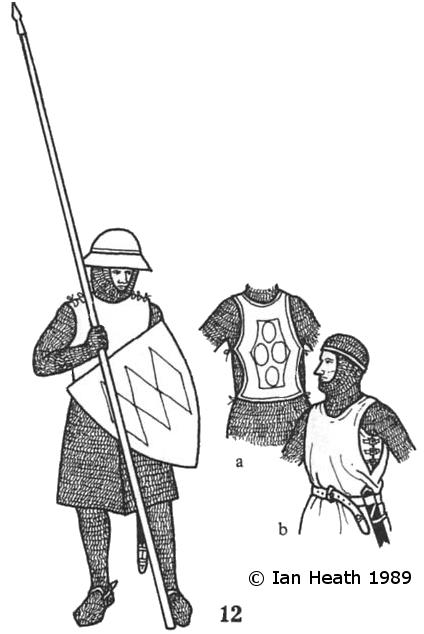|
|
 |
KNIGHT c.1270
An extract from Armies of Feudal Europe 1066-1300
by Ian Heath
|
12. KNIGHT c.1270
As well as the usual full mail armour this man, based on the brass of a Flemish knight (Brocardus de Charpignie), wears some form of additional body-armour laced at the shoulders and probably also at the sides.
This is fairly certainly a cuirie or curie, a term which first appears in Wace’s ‘Roman de Rou’ of 1160-74, clearly deriving its name from cuir (leather).
Initially at least it appears to have been a leather breastplate, sometimes reinforced with metal (as in 12a, from an English ms. of c. 1260) and occasionally having sleeves.
Before long, however, solid metal breastplates were also in use, William le Breton recording Richard I wearing a breast plate of iron in 1188.
Figure 12b depicts such a plastron de fer, from a sepulchral relief of c.1280 in Pershore Abbey, Worcestershire;
a similar defence is also to be seen in an early-13th effigy in the Temple Church, London.
In both instances it is clearly worn over the hauberk but under the surcoat, which is also the way in which Wace records it used.
William le Breton, however describes it as being worn under the hauberk and the gambeson too, so clearly this was a matter or personal preference.
A kettle-helmet is worn in place of the heaume.
This was in no way unusual by the mid-13th century as is proved by the frequent appearance of knights wearing kettle-helmets in many contemporary sources including the
‘Chronica Majora’ and
‘Maciejowski Bible’, and there is a passage in Joinville relating how Louis IX was loaned one by another knight during the Seventh Crusade.
The only other feature worthy of special attention is that mail gloves with individual fingers have now replaced mittens, though still attached to the sleeves These seem to have appeared in the late-12th century but were always rare.
[Based on the brass effigy of Brocardus de Charpignie.]
|
|